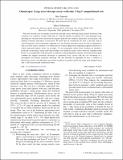Omniscopes: Large area telescope arrays with only N logN computational cost
Author(s)
Zaldarriaga, Matias; Tegmark, Max Erik
DownloadPhysRevD.82.103501.pdf (955.8Kb)
PUBLISHER_POLICY
Publisher Policy
Article is made available in accordance with the publisher's policy and may be subject to US copyright law. Please refer to the publisher's site for terms of use.
Terms of use
Metadata
Show full item recordAbstract
We show that the class of antenna layouts for telescope arrays allowing cheap analysis hardware (with correlator cost scaling as Nlog N rather than N[superscript 2] with the number of antennas N) is encouragingly large, including not only previously discussed rectangular grids but also arbitrary hierarchies of such grids, with arbitrary rotations and shears at each level. We show that all correlations for such a 2D array with an n-level hierarchy can be efficiently computed via a fast Fourier transform in not two but 2n dimensions. This can allow major correlator cost reductions for science applications requiring exquisite sensitivity at widely separated angular scales, for example, 21 cm tomography (where short baselines are needed to probe the cosmological signal and long baselines are needed for point source removal), helping enable future 21 cm experiments with thousands or millions of cheap dipolelike antennas. Such hierarchical grids combine the angular resolution advantage of traditional array layouts with the cost advantage of a rectangular fast Fourier transform telescope. We also describe an algorithm for how a subclass of hierarchical arrays can efficiently use rotation synthesis to produce global sky maps with minimal noise and a well-characterized synthesized beam.
Date issued
2010-11Department
Massachusetts Institute of Technology. Department of PhysicsJournal
Physical Review D
Publisher
American Physical Society (APS)
Citation
Tegmark, Max, and Matias Zaldarriaga. “Omniscopes: Large Area Telescope Arrays with Only N Log N Computational Cost.” Physical Review D, vol. 82, no. 10, Nov. 2010.
Version: Final published version
ISSN
1550-7998
1550-2368